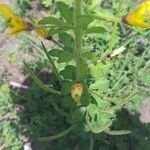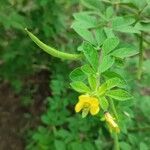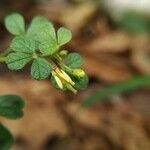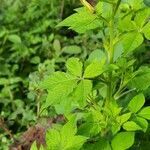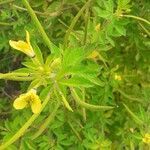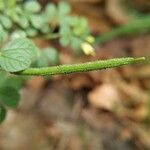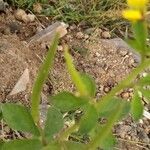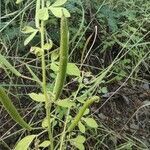Annual herb, erect, unbranched or branched, to 1.5 m high, glandular-pubescent, unarmed. Leaves 3–5-foliolate, exstipulate; petiole 1–6 cm long; leaflets oblanceolate to elliptic, acute to obtuse or rounded, 0.6–6 cm long, 0.5–3 cm wide, entire, glandular-ciliate; base attenuate to cuneate. Inflorescence a bracteate raceme. Sepals 5–10 mm long, usually deciduous. Petals 7–14 mm long, attenuate to scarcely clawed, yellow. Stamens 10–26, free, included. Ovary sessile, glandular-pubescent. Siliqua linear, erect, 3–10 cm long, 2–4 mm wide, on pedicels 6–30 mm long; valves longitudinally striate, glandular-pubescent, persistent; style to c. 5 mm long. Seeds suborbicular, 1.3–1.8 mm long, transversely rugose, cleft closed but not fused, aril absent.
Annual herb, branched above, erect, up to 1 m. tall, foul smelling.. Stem angular, rather densely glandular-hairy.. Leaves petiolate, 3–5-foliolate; leaflets obovate, up to 4 cm. long, obtuse or rounded, sometimes retuse, at the apex, cuneate at the base; petiole up to 14 mm. long.. Inflorescence up to 30 cm. long, with few corymbose ephemeral flowers at the top; rhachis markedly elongating in fruit; bracts foliaceous, scarcely smaller than the leaves.. Sepals lanceolate, 4–6 mm. long, glandular-puberulous.. Petals 6–9 mm. long, yellow.. Stamens 10–20.. Gynophore absent.. Capsules 3.5–7.5 cm. long, glandular-hairy.. Seeds ±1.4 mm. in diameter, dark brown with fine longitudinal striations and conspicuous transverse ridges.
An erect annual herb. It is sticky. It has a rank smell and is about 0.3 to 1 m high. The leaves are made up of 3 to 5 leaflets each 1 to 3 cm long. The flowers are in leafy groups at the end of branches. The flowering shoots are 5-10 cm long. The flower stalks are less than 1 cm long. The petals are yellow and 7 to 8 mm long. The fruit is a capsule 3-10 cm long by 2-4 mm wide. It has ridges along it. It partly splits open. It is narrow. It narrows and gradually tapers near the tip. The stems and seed pods are hairy. The seeds are round, black and 1 mm across. There are 25-40 seeds. They are light brown and 1.2-1.8 mm long by 1-1.2 mm wide. They have fine ridges.
Erect herb, to 2 ft. high, very sticky
Flowers yellow.
